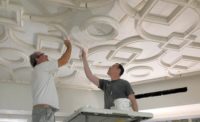The Richardsville Elementary School was recently the first net-zero insulated concrete form school in the U.S. Warren County School district. The school board responsible for Richardsville has been building energy efficient schools that are being recognized for their innovation across the United States. Designed by Sherman Carter Barnhart and located in Bowling Green, Ky., Richardsville was created to be a two-story, energy efficient structure that incorporated renewable materials and NUDURA insulated concrete forms for a superior building envelope.
The design and north-south site orientation allowed the school to maximize the use of renewable energy resources, such as wind and solar, so that it can produce more energy than it consumes. It’s a popular topic when it comes to a structure’s carbon footprint, its effect on human health, and its high-energy costs.
project details
Location: Bowling Green, Ky.
Distributor: Holdfast Technologies
Architect: Sherman-Carter-Barnhart
Engineer: CMTA Engineering Consultants
Contractor: R.G. Anderson Company Inc.
Cost: $14 million
Size: 72,285 square feet
Other ICF Uses: Interior walls, fire walls, shear walls, load bearing walls
Research provides evidence that schools throughout North America are moving toward greener and healthier building solutions and the demand for energy performance has become increasingly more important. At 72,285 square feet and generating its own energy, Richardsville is the next generation of educational building standards and a valuable tool to educate students on energy and water conservation as well as the value of recycling. The concerns associated with designing a net-zero structure are usually cost, time, and the best eco-friendly building solution available.
In order to meet this list of demands the Warren County School Board decided to use ICF construction to maximize the structure’s energy performance and minimize energy costs. The result was a high-performance building envelope using forms for the interior and exterior walls. The manufacturer’s ICFs provide a highly insulated concrete wall made up of EPS foam connected by a web that is reinforced with steel and filled with concrete. The walls come in a variety of sizes ranging from 4- to 12-inch concrete cores and provide performance values as high as R-50.
The benefits of using the the system for this structure were its strength, maximum energy efficiency, eco-friendly materials, sound and fire resistance, design flexibility, speed of the construction process, and EPS foam that doesn’t support mold growth. The performance value of forms used in structures, like Richardsville, can generate energy savings up to 60 percent annually. Richardsville Elementary is designed to use only 18 kBtu/square feet—75 percent less than the ASHRAE 90.1 Design Standard for elementary schools annually.
Other “green” components that contributed to the overall net-zero design were: solar panels, geothermal HVAC with CO2 monitoring and de-centralized pumping, solatubes, Energy Star-rated kitchen appliances, active daylighting, sunshade devices to minimize heat and glare, motion sensors, and an efficient maintenance and operation plan. Reusing materials was another key factor in the design plan. Such as the new gymnasium floor, which was made mostly from bamboo and hardwood sections salvaged from the old gymnasium.
The 500 students attending the Richardsville net-zero school will enjoy a healthy, eco-friendly learning environment that sets the standard high to future generations looking to build sustainable educational institutions. Architects and builders are always looking for solid strategies that reduce energy demands, carbon footprints, and operational costs. The important thing is to have a strategy and a building product that makes the switch to green construction simple. As a key component to the overall building aspect of the Richardsville net-zero project, NUDURA has met and exceeded those highly demanded qualities and continues to help to make green schools a possibility for any community.
Next Generation of Education Building Standards
Richardsville Elementary is a valuable tool to educate students on energy and water conservation as well as the value of recycling. The halls at Richardsville are decorated and themed with the building’s environmental design features such as its water conservation, solar power, recycling programs, and much more. The building also features a wireless outdoor classroom outfitted with its own net-ready solar powered weather station that is capable of monitoring barometric pressure, rainfall, temperature, humidity, wind speed and wind direction.
Energy Savings—A Comparison
The average U.S. Elementary School’s utility bill for one month is approximately $7,000. Richardsville generated enough solar energy (in eight sunny days in the course of a month) that they covered over $4,300 in utility charges each month and received a credit of roughly $40,000 (each year) for selling the energy back to the electric company each month.


























